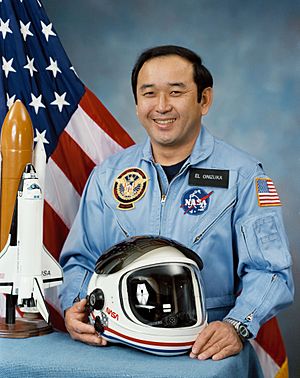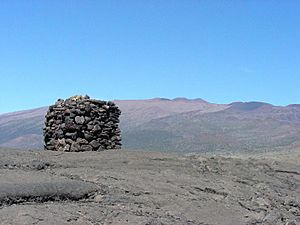Onizuka Center for International Astronomy facts for kids
The Onizuka Center for International Astronomy, also called Hale Pōhaku, is a special base camp. It helps support the giant telescopes and other tools at the Mauna Kea Observatory. This observatory is located high up on Mauna Kea mountain, on Hawaiʻi Island.
Contents
History of Hale Pōhaku
Long ago, in the 1930s, some simple cabins were built on Mauna Kea. These cabins were called Hale Pōhaku, which means "stone house" in the Hawaiian language. They were used by hunters and explorers.
In 1964, a rough road was built up the mountain. Scientists then used a small telescope to discover that Mauna Kea was a perfect spot for an observatory. This was because the air there is very clear and dark, great for looking at stars.
The Hale Pōhaku area became a camp for workers building the observatories. In 1983, new, permanent buildings were constructed. This new complex was called the Mid-Level Facility.
Honoring Ellison Onizuka

The Mid-Level Facility was later renamed to honor Ellison Onizuka. He was an astronaut born in Hawaiʻi. Sadly, he passed away in the Space Shuttle Challenger disaster in 1986.
The center is located about 9,300 feet (2,835 meters) up the mountain. It has dorms where up to 72 people can sleep. There is also a main building with a cafeteria, laundry, and a common room.
Why Astronomers Stay Here
Astronomers and technicians often stay at Hale Pōhaku for about 24 hours. This helps their bodies get used to the high altitude. After that, they go up to the very top of the mountain, which is almost 14,000 feet (4,267 meters) high. The public cannot visit these support buildings. The Institute for Astronomy at the University of Hawaii runs the center.
The telescopes at the top need constant care. So, technicians and construction workers often live at Hale Pōhaku. In the past, astronomers had to be physically present to use the telescopes. Now, most observations can be done using the Internet. Teams often work together, with some at the summit and others connected by video call from Hale Pōhaku or other university locations.
Visiting Mauna Kea

Just below the main support complex is the Visitor Information Station (VIS). It has its own parking lot for visitors. Inside, you can find displays and videos about the observatories. You can also learn about Mauna Kea's geology, nature, and cultural importance.
Staff or volunteers at the VIS often give tours of the stars. They use a laser pointer to show constellations in the night sky. Many Amateur astronomers also come here to set up their own telescopes. The altitude is high enough for much clearer views of the sky.
Reaching the Summit
The Onizuka Center is where the paved road ends. Most regular cars should not go beyond this point. As of 2025, if you want to drive the steep, gravel road to the summit, you need a four wheel drive vehicle. It must also have good brakes. It is important to check for updated road conditions before going past the VIS.
Visitors planning to go to the summit should spend at least 30 minutes, or even three to four hours, at the mid-level. This helps your body adjust to the higher elevation. It also reduces the chance of getting altitude sickness, which can be dangerous.
A separate camp for construction workers is located below the visitor station. These three areas are kept apart. Scientists work at night and need to sleep during the day. Construction and tours happen during daylight hours.
Other Places to Explore
The W. M. Keck Observatory at the summit has a visitor gallery. It is usually open on weekdays. You can also reserve free tours of the Subaru Telescope online. Otherwise, only observatory staff and visiting scientists are allowed inside the observatory buildings. Some tour companies offer trips from the center to the summit. These tours run from before sunrise until after sunset.
Other fun things to do on Mauna Kea include visiting the Mauna Kea State Recreation Area. There is also the Mauna Kea Trail, which goes from the VIS through the Mauna Kea Ice Age Reserve to the summit. A small museum about Ellison Onizuka was located at the Kona International Airport. The ʻImiloa Astronomy Center in Hilo has a larger museum and planetarium. It is easier for visitors to access.



